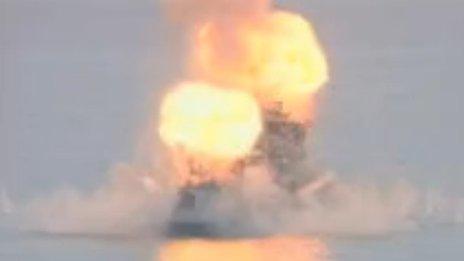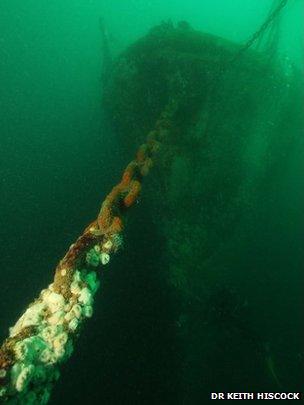Warrior vessel HMS Scylla haven for marine life
- Published

March 2004 and former Royal Navy frigate HMS Scylla is scuttled

March 2009 and the colonisation of the wreck has settled down

Summer 2013 and divers continue to visit the beautifully adorned wreck
Former Royal Navy frigate HMS Scylla was scuttled in Whitsand Bay near Plymouth in March 2004 and has attracted thousands of divers to the area.
But as well as boosting tourism, Scylla is now a source of information for scientists about how marine life colonises man-made objects such as offshore wind farms.
When HMS Scylla was sunk by a series of explosions, it was the signal for marine life to drop in.
Within a month tube worms, barnacles and spider crabs were all exploring the nooks and crannies of the 2,500-tonne frigate.
The rusting vessel had become the resting place for scallops, anemones and mussels after about three months.
And after six months starfish and urchins had made it their new home in large numbers.
'Obvious project'
Within a year 53 species had been recorded on the Scylla and by 2006 that number had exploded to at least 220. There are now about 250 species on the wreck.
Diver and scientist Dr Keith Hiscock, an associate fellow at the Plymouth-based Marine Biological Association (MBA), has been visiting the Scylla and its inhabitants since 2004 and has seen the changes in the wreck's new-found occupants.
"In 2004 very little was known about how marine life colonised man-made structures," he said.
"When the Scylla was put on the seabed it was an obvious project to pursue."
In Autumn 2004 there was a large settlement of queen scallops. This was quickly followed by a huge number of starfish that ate all the scallops then died out themselves.
"For a few years things were all over the place," said Dr Hiscock.
"We got an enormous number of green sea urchins, which you don't see on open rocky surfaces.
"They grazed off the seaweed and barnacles so everything on the hull was stripped bare.
"Then when the wrasse came along, which prey on urchins, there were masses of sea urchin shells."
Mature community
After that "things began to settle down" and anemones and other species moved in to create an "underwater garden".
Dr Hiscock said: "Following the sequence of colonisation on Scylla has helped us to better understand recovery processes in marine ecosystems.
"The reef had reached a mature community of species characteristic of steel wrecks after about four years, although many of the species that characterise rock reefs in the area had not settled on Scylla and probably will not."

Scylla looms in the distance from a sea life-encrusted anchor chain
Every weekend in the summer there are at least six dive boats with six to 12 divers on each poring over the delicate and beautiful underwater garden.
Divers are encouraged to report their findings via the Seasearch project for volunteer divers.
Dr Hiscock said: "Scylla is now a very attractive reef colonised by colourful species doing what she was supposed to do, providing a recreational experience for divers.
"But the scientific spin-off has been significant and, apart from the scientific paper describing colonisation of the reef published in 2010, experience on Scylla has informed a further paper on species recovery published this year.
"Whilst the colonisation studies on Scylla were seen as informing what should be expected to grow on offshore structures such as wind farms, they have been most value in understanding likely recover rates in damaged habitats."
Dr Hiscock's predictions for the MBA on the colonisation of the North Hoyle wind farm off the north Wales coast near Rhyl had been "spot on".
He said: "Offshore wind farms are usually put in places where they are benign, but we may come across a situation where an environmental survey finds species that could be damaged and the answer is you shouldn't build your wind farm there.
"That is the sort of information that the MBA is making available."
The colonisation of the wreck by green sea urchins, not found on rocks, also showed how an an object like the Scylla can actually increase the number of species.
Dr Hiscock said: "They have also reminded us that what settles on artificial structures is different to what settles on natural reefs and sinking frigates should not be seen as offsetting damage to natural habitats."
- Published14 March 2012